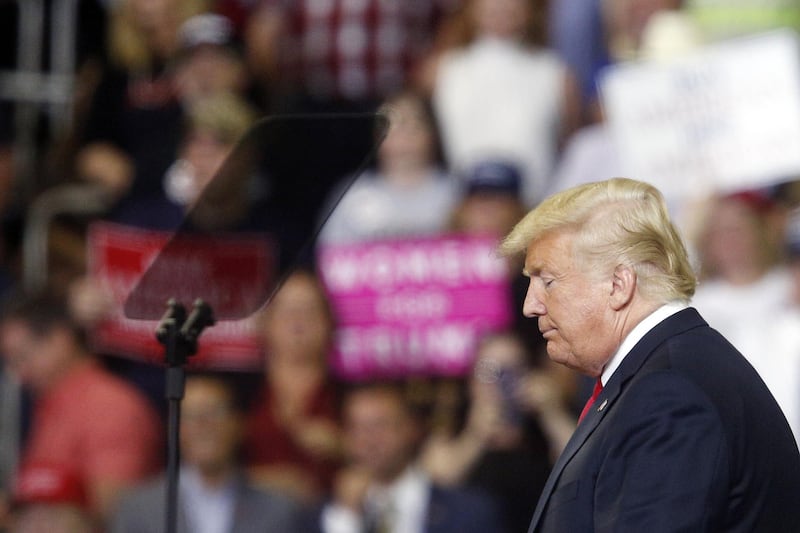President Donald Trump wants to move ahead with a plan to impose tariffs on $200 billion in Chinese imports as soon as a public-comment period concludes next week, according to six people familiar with the matter.
Asked to confirm the plan in an interview with Bloomberg News in the Oval Office on Thursday, Mr Trump smiled and said it was "not totally wrong." He also criticised management of the yuan, saying China has devalued its currency in response to a recent slowdown in economic growth.
Companies and members of the public have until September 6 to submit comments on the proposed duties, which cover everything from selfie sticks to semiconductors. The president plans to impose the tariffs once that deadline passes, according to the people familiar with the matter, who spoke on condition of anonymity because the discussions aren’t public.
Broadening the tariff battle would mark the most significant move yet in a months-long trade standoff and dent China’s growth prospects. Data released on Friday will allay some concerns over the near-term outlook as China’s official factory gauge unexpectedly strengthened this month following government measures to underpin demand.
"China is more prepared, mentally, this time than it was for the previous round of tariffs," said Gai Xinzhe, an analyst at the Bank of China’s Institute of International Finance in Beijing. "The scale is enormous and once the tariffs materialise, they will definitely send jitters through financial markets."
Such unease was already on display Friday as Asian stocks declined, following losses in the US, where the S&P 500 tested the key 2,900 level. Treasuries, the dollar and the yen held on to gains. The tariff news exacerbated already fragile market sentiment amid currency routs in Argentina and Turkey.
Some of the people cautioned that Trump hasn’t made his final decision, and it’s possible the administration may enact the duties in instalments. The US has so far imposed levies on $50 billion in Chinese goods, with Beijing retaliating in kind.
It’s also possible the president could announce the tariffs next week but say they will take effect at a later date. The Trump administration waited about three weeks after announcing in mid-June that it was imposing tariffs on $34 billion of Chinese goods before they were implemented. The next stage of tariffs on $16 billion of goods took hold in August.
China has threatened to retaliate by slapping duties on $60 billion of US goods. The ministries of finance commerce didn't immediately respond to Bloomberg faxes seeking comments on Mr Trump's intentions.
The Trump administration is finalising the list of Chinese targets and tariff rate, which could range from 10per cent to 25 per cent, following six days of public hearings earlier this month. Trump’s plan to bring down his biggest hit yet on China comes as two-way trade talks show little signs of progress.
_______________
Read more:
PetroChina's surging profits a lucky break for shareholders
Details emerge of US and Mexico Nafta 2 deal, putting squeeze on Canada
_______________
China hawks have been on the ascendancy in the Trump administration. One of them -- US Trade Representative Robert Lighthizer -- has been responsible for one of the president’s biggest trade victories so far by forging a bilateral trade deal to replace Nafta with Mexico. The deal was announced on Monday and Canada is now negotiating to join.
The latest China tariff decision is causing heated debate within the administration, with Lighthizer and White House trade adviser Peter Navarro pushing for quick action, and Treasury Secretary Steven Mnuchin and White House economic adviser Larry Kudlow arguing for more time, according to people familiar with the matter.
Mr Trump cut off negotiations with China because of what he perceives as Beijing’s lack of cooperation in nuclear talks with North Korea, one of the people said. The president wants to squeeze China, believing the US has leverage over Beijing, that person said.
Trump on Wednesday accused China of pressuring North Korea not to bend in nuclear negotiations with the US. But he insisted that the trade differences would be resolved.
“As for the US-China trade disputes, and other differences, they will be resolved in time by President Trump and China’s great President Xi Jinping. Their relationship and bond remain very strong,” Mr Trump said on Twitter.
Edward Alden, a senior fellow at the Council on Foreign Relations in Washington, said that Lighthizer’s Nafta successes were strengthening his hand with the president. That raised the possibility that after months of being passed around various figures in the administration, the talks with China could finally end in the hands of one of its most able negotiators and influential China hawks.
If the president “hands the China file to Lighthizer, there’s a chance of real progress," Alden said. Nafta “is clearly a personal triumph for Lighthizer. He did this deal.”
Putting him in charge of China talks, were it to happen, “at least opens the door to a serious negotiation with China which we have not seen yet,” Mr Alden added.






